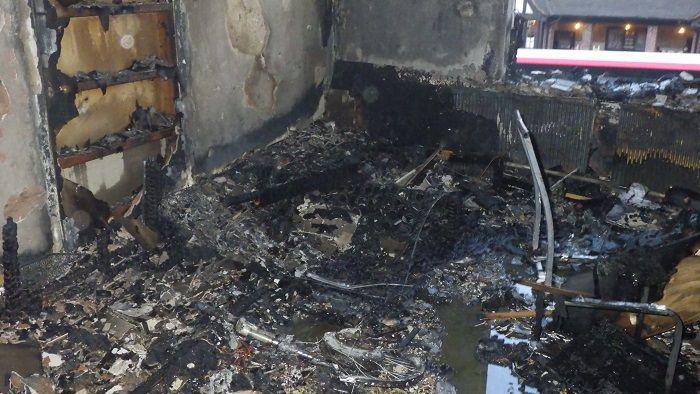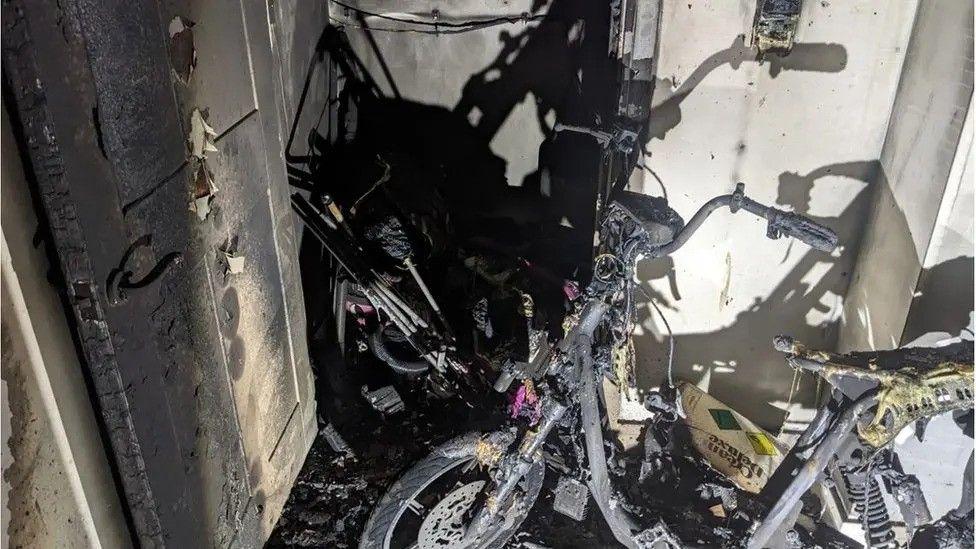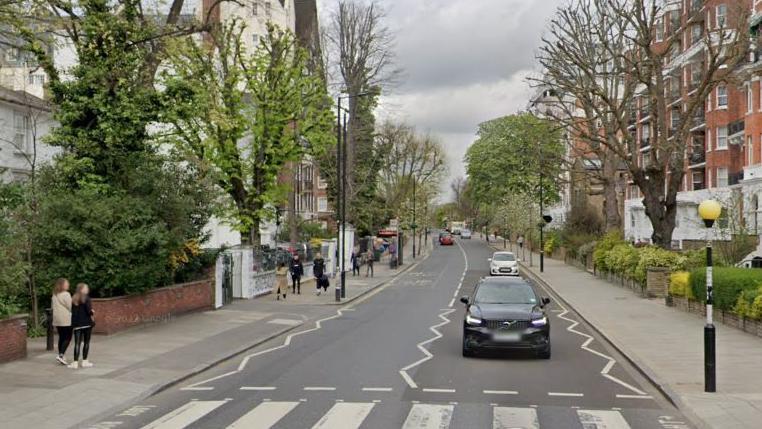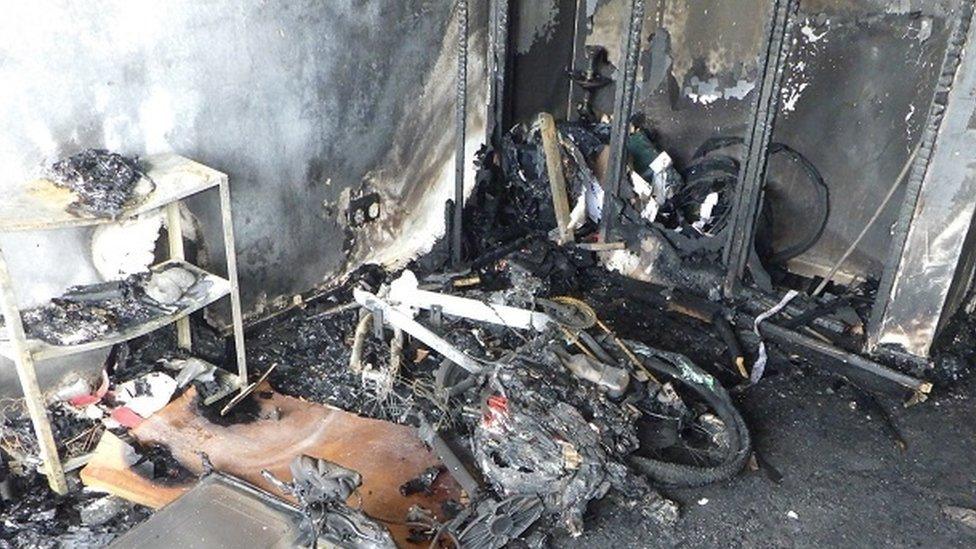Why are modified e-bikes causing house fires?
An e-bike battery starts a fire in a London kitchen
- Published
There has been a rise in the number of fires in London caused by e-bikes that have been modified using parts bought online.
The fire service says e-bikes are becoming one of the capital’s fastest-growing fire risks with more than 130 fires in London up to the end of September – more than three a week.
Last year there were three deaths and 60 injuries from e-bike fires and London Fire Brigade (LFB) attended 143 e-bike fires plus 36 involving e-scooters.
So what are the risks, what should you watch out for and how can you protect yourself and your property?
What causes e-bikes to catch fire?
LFB says many of these fires are caused by incompatible chargers, modifications to e-bikes, or faulty or counterfeit products which are purchased online.
This includes chargers, lithium batteries and conversion kits for e-bikes.
"E-bikes and e-scooters can pose a significant fire risk and particularly the batteries used to power them have become one of London's fastest-growing fire risks," says LFB deputy commissioner Charlie Pugsley.
"They have destroyed homes, and families have sadly lost loved ones in these fires. Many of the fires we’ve attended have involved secondhand vehicles or bikes that have been modified using parts bought online."
E-bikes and e-scooters are powered by lithium batteries, which store a significant amount of energy in a very small space and are much more powerful compared with other types of batteries.
If that energy is released in an uncontrolled way, then a fire or explosion may result.
Overheating, crushing, penetrating or overcharging can cause a fault in damaged battery cells which can cause the battery to catch fire or explode.

The damage caused by e-bike fires can be extensive
How can e-bike owners protect themselves?
LFB says when owners are charging their e-bike or e-scooter, or the batteries for them, they should make sure they are using the correct charger.
It is also important not to overcharge and to unplug the charger once it has completed charging.
Never charge an e-bike or e-scooter unattended or while you are sleeping and do not charge it on an escape route, such as in a hallway.
LFB says: “Instead, charge or store the device outdoors or in a shed. If this is not possible, make sure the device is in a room where you can shut a door and contain a fire and that you have smoke detection fitted."
Online DIY kits for converting pedal bikes into e-bikes can be very dangerous.
"Get a professional or competent person to carry out the conversion and make sure to buy a battery from a reputable seller and that it is not secondhand," LFB adds.

Private e-scooters and e-bikes have increased in popularity over recent years
What do insurance companies say about e-bikes?
A spokesperson for the Association of British Insurers (ABI) told BBC London that lithium battery fires can be particularly dangerous and hard to extinguish.
"When charging anything that uses a lithium-ion battery, be sure to only do so using the accessories specifically designed for the device’s make and model, and watch out for excessive heat, smells, bulging or leaks which could indicate battery failure,” the spokesperson says.
The ABI says the adoption of battery-powered e-bikes and e-scooters is becoming an emerging fire risk - particularly when devices are damaged or modified, or when incorrect or counterfeit chargers are used.
The spokesperson adds: "Insurers, fire departments, and industry stakeholders want to see our safety regulations modernised and enforced to mitigate against the fire risks that they pose.”
Property owners are advised to make sure to have the correct smoke alarms and fire safety equipment installed.
In addition, batteries should only be charged with accessories specifically designed for the device’s make and model and should not be charged in areas where an exit could be obstructed or left to charge overnight.

E-bikes are a growing cause of home fires
What are the warning signs?
London Fire Brigade has issued these warning signs for lithium batteries:
Heat: It is normal for batteries to generate some heat when charging or in use. However if your device’s battery feels extremely hot to the touch, there’s chance it is defective and may start a fire.
Bulging: A battery bulging or swelling out of shape is a common sign of it failing. If your battery looks swollen, you should stop using it immediately. Similar signs include any type of lump or leaking from the device.
Noise: Failing lithium batteries have also been reported to make hissing or cracking sounds.
Smell: If you notice a strong or unusual smell coming from the battery, this could also be a sign of it failing.
Performance: A failure to fully charge or longer charge times can be a sign that your battery is failing.
Smoke: If your battery or device is smoking, a fire has already started.
If the device starts smoking or catches fire you should not try to tackle the fire yourself - get out, raise the alarm, call 999.
LFB is promoting the #ChargeSafe campaign to raise awareness about the fires as well as calling for legislation for online marketplaces to ensure products like batteries, chargers and conversion kits are strictly regulated.
The Department for Business and Trade has also launched its Buy Safe, Be Safe campaign, external, which is designed to urge the public to buy safe e-bikes and e-scooters and avoid rogue online sellers.
More information on how to protect yourself from e-bike and e-scooter fires can be found on the London Fire Brigade website., external
Listen to the best of BBC Radio London on Sounds and follow BBC London on Facebook, external, X, external and Instagram, external. Send your story ideas to hello.bbclondon@bbc.co.uk, external
- Published11 October 2024

- Published31 July 2024

- Published8 April 2024

- Published18 September 2023
